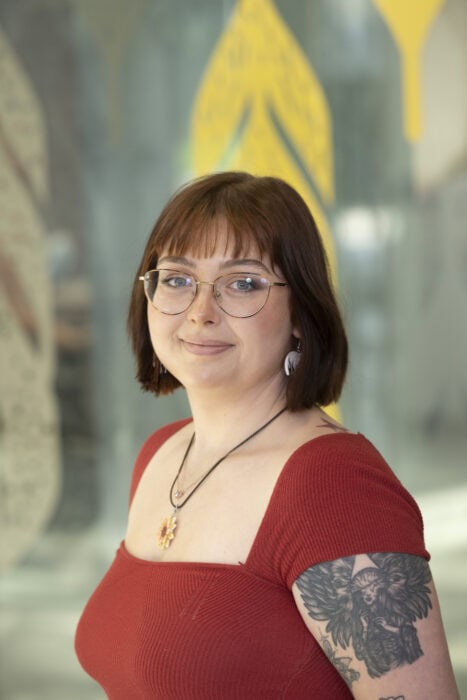Amy Eden they/them

Doctoral researcher in Quantum Technologies
Strategic Research Areas
I am a doctoral researcher specialising in quantum technologies, focusing on the integration of magnetic materials with superconducting resonator circuits to create hybrid quantum systems. My research aims are to understand and engineer strong magnon–photon coupling by exploring new magnetic materials, with the goal of developing scalable and coherent hybrid quantum devices that integrate spin dynamics and superconducting circuits for applications in quantum information processing and memory.
I hold a Bachelor’s degree in Computing Science and a Master’s in Quantum Technology, where my Master’s dissertation focused on Resonant Coupling Control in Ring Resonators for Hybrid Quantum Systems. This project explored coupling mechanisms between YIG-based resonators, investigating wireless energy transfer analogues and readout strategies inspired by qubit systems. Through this work, I developed a strong foundation in experimental resonator physics and coupling control, which directly informs my current doctoral research.
I value DiveIn’s approach to doctoral research, which emphasises innovation, diversity, and interdisciplinarity. These principles are essential for creating a healthy and inclusive research environment that not only supports individual well-being but actively amplifies voices from underrepresented and minority groups. By encouraging collaboration across disciplines, this approach leads to more creative problem-solving and richer, more impactful research outcomes. These values resonate deeply with both my personal identity and professional aspirations. I’m also proud to contribute directly to EDI initiatives within the James Watt School of Engineering through my role as an EDI Data Intern, where I support efforts to improve equity and inclusion across the university using data-driven and analytical approaches.
Outside of research, I enjoy playing board games—particularly Dungeons & Dragons, which combines creativity, strategy, and collaborative storytelling. I also make time to “touch grass” with hobbies like hiking, climbing, and weightlifting, which keep me grounded and active outside the lab.
Resonant coupling control in superconducting resonators for hybrid quantum systems
Motivation
Building on recent breakthroughs in on-chip hybrid magnon–photon systems based on Yttrium Iron Garnet (YIG) and superconducting resonators [1,3], this PhD project aims to expand the material platform for hybrid quantum systems based on magnonics beyond YIG.
While YIG has long been the benchmark for magnonic applications due to its exceptionally low spin-wave damping and long coherence times [1], its reliance on nonstandard substrates and complex fabrication methods limits scalability and integration with superconducting quantum circuits and CMOS-compatible technologies [2]. Moreover, YIG’s isotropic magnetic response and narrow tunability range restrict the design flexibility of hybrid quantum devices.
Exploring alternative magnetic materials may offer new opportunities to tailor spin–photon coupling, enhance frequency tunability, and achieve new coupling regimes. Such materials could also bring additional functionalities, including electrical gating, magneto-optical effects, or topological spin textures, to hybrid quantum architectures.
This project is motivated by the vision of developing a versatile material platform for cavity spintronics and quantum hybrid technologies, enabling coherent information transfer between photons, magnons, and potentially other quasiparticles such as phonons or excitons.
Aims
The primary aim of the project is to overcome the incompatibility issues of YIG by exploring different materials to achieve strong magnon–photon coupling in a system integrated on a chip, specifically at sub-Kelvin temperatures.
Specific aims included:
- Developing a method for integrating magnetic materials with superconducting quantum technologies using Plasma Focused Ion Beam (PFIB) technologies.
- Achieving strong coupling between superconducting resonators and magnetic resonance modes of high-quality magnetic materials while maintaining low loss and reducing the system scale to the micrometer range.
- Developing a comprehensive theoretical framework to understand the coupling in hybrid systems by investigating the electromagnetic properties of both the resonator and the magnetic samples.
- Employing an accurate electromagnetic perturbation theory to predict the resonant hybrid mode frequencies for any field configuration within the cavity resonator.
Methodology
The project will utilise both advanced fabrication techniques for on-chip integration and a rigorous theoretical approach based on electromagnetism.
Fabrication and Measurement:
- Superconducting planar devices are to be fabricated from 100 nm-thick niobium nitride (NbN) films deposited on intrinsic silicon substrates. NbN is selected for its high critical field values, ensuring stable operation under applied magnetic fields [4].
- Plasma Focused Ion Beam (PFIB) technology will be employed for high-precision processing and integration of the chosen magnetic materials. Microstructures will be milled from bulk or thin-film sources into rectangular cuboid or tailored geometries (typically 5–50 µm in dimension), optimised for coupling to the resonator field.
- A nanomanipulator will be used to precisely position and affix the PFIB-processed magnetic samples onto prefabricated NbN microwave devices via localised platinum (Pt) deposition. The samples will be placed at the magnetic antinode of the lumped-element resonator’s inductive line, where the oscillating microwave magnetic field is maximised [3].
- Ferromagnetic resonance (FMR) spectra and magnon–photon coupling measurements will be conducted at milliKelvin temperatures (down to 80 mK) using an adiabatic demagnetisation refrigerator equipped with a superconducting solenoid to apply a tunable static magnetic field. The microwave transmission parameter (S_{21}) will be recorded using a vector network analyser (VNA) to identify hybridised resonant modes and quantify coupling strength.
Theoretical Framework:
- The project employs an electromagnetic perturbation theory combining the Landau–Lifshitz equation with Maxwell’s equations to describe the interaction between superconducting resonator fields and magnetic resonance modes.
- The model incorporates the dynamic magnetic susceptibility tensor, accounting for sample geometry, anisotropy, and demagnetisation effects.
- Assuming small magnetic perturbation and a negligible dielectric contribution, the framework enables the calculation of hybrid mode frequencies and coupling strengths based on cavity parameters and stored energy ratios.
- This approach can be applied to various magnetic materials and geometries, providing a predictive tool for understanding and optimising magnon–photon coupling in hybrid quantum systems.
Impact
This research extends on-chip hybrid magnon–photon systems beyond YIG, advancing materially diverse and scalable cavity spintronic platforms for quantum technologies.
Key Objectives and Expected Achievements:
- Develop a general integration framework for coupling superconducting resonators with various magnetic materials using PFIB-based microfabrication.
- Demonstrate strong magnon–photon coupling across multiple materials while maintaining low loss and high cooperativity.
- Apply and extend electromagnetic perturbation theory to predict hybrid mode frequencies and coupling strengths without empirical parameters.
- Understand how material properties (damping, anisotropy, spin density) affect coupling, coherence, and device performance.
Future Significance:
- Enable customisable hybrid quantum devices with tunable coupling through material selection.
- Guide the design of scalable quantum components such as spin-based memories, microwave–optical transducers, and hybrid logic elements.
- Provide a predictive theoretical framework for optimising complex magnetic systems and novel materials in cavity spintronics and quantum information science.
References
[1] P. G. Baity, D. A. Bozhko, R. Macˆedo, W. Smith, R. C. Holland, S. Danilin, V. Seferai, J. Barbosa, R. R. Peroor, S. Goldman, et al. Strong magnon–photon coupling with chip-integrated yig in the zero-temperature limit. Applied Physics Letters, 119(3), 2021.
[2] B. Lenk, H. Ulrichs, F. Garbs, and M. M¨unzenberg. The building blocks of magnonics. Physics Reports, 507(4-5):107–136, 2011.
[3] R. Macedo, R. C. Holland, P. G. Baity, L. J. McLellan, K. L. Livesey, R. L. Stamps, M. P. Weides, and D. A. Bozhko. Electromagnetic approach to cavity spintronics. Physical Review Applied, 15(2):024065, 2021.
[4] A. Banerjee, R. M. Heath, D. Morozov, D. Hemakumara, U. Nasti, I. Thayne, and R. H. Hadfield. Optical properties of refractory metal based thin films. Optical Materials Express, 8(8):2072–2088, 2018.
This project establishes a flexible platform for studying hybrid magnon–photon systems using a variety of magnetic materials integrated with superconducting resonators. I welcome collaboration with researchers interested in exploring new magnetic materials, hybrid device architectures, or theoretical modelling of spin–photon interactions.
I am keen to share expertise in superconducting device fabrication, PFIB-based magnetic material integration, and low-temperature microwave measurements with collaborators from both academia and industry.
Potential Collaboration Areas:
- Materials scientists exploring magnetic materials
- Quantum and device physicists integrating hybrid systems with qubits or transducers.
- Microwave engineers designing resonators and scalable on-chip architectures.
- Industrial partners exploring applications in quantum communication, sensing, and signal transduction.
